An all new suspension was obviously required, and MacPherson struts were chosen for all four corners, with wide semi-trailing lower wishbones at the rear.
Anti-roll bars were fitted at both the front and the rear. Disc brakes were specified all round, taken from the front of the 128. The structure was very rigid due to both
the floor, which had massive box section sills and a central tunnel and the use of several transverse bulkheads, one behind the radiator, one behind and one in-front of the cockpit, one behind the
engine and a final one serving as the rear outer body.
The external styling was nothing if not modern when it was launched. Wedge shaped, with a large forward sloping anti-roll bar, pop-up headlights and
a significant chin spoiler (designed to get air through the front-mounted radiator) details such as the two air inlets to the engine added to its appeal.
The bodies were completely built by Bertone who then shipped them to Fiat for the installation of all the mechnical parts.
1983 saw the complete production of the X1/9 (along with the 124
Spider) pass away from Fiat, in the case of the X1/9 to Bertone who
rebadged it as the Bertone X1/9 (nothing really changed except the badges). It continued to be
sold through Fiat dealers until production finally stopped in 1988.
See our 'Concept
Cars' page for images of the concept car which preceded the X1/9
- the Bertone Runabout of 1969. A rally version was also built, the Prototipo by Abarth, some pictures of which
can be seen on our Bonfanti Abarth exhibition page.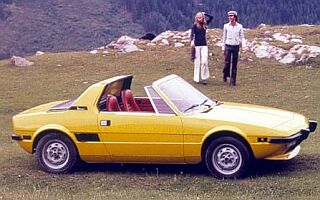 Designed by Bertone as the replacement for the 850 Spider,
the Fiat X1/9 was a radical departure from the norm for Fiat when it was released
in 1972. It was an all-new car using the engine, drivetrain and most mechanical units from the 128.
The novelty, however, was that the 1290cc (75bhp or 66bhp in the US) engine was positioned transversely behind the only two seats and drove the rear
wheels. The entire engine/gearbox/driveshafts unit was taken directly from the 128 and 'simply' rotated through 180 degrees for packaging reasons. A
new gearchange mechanism was designed specifically for the X1/9.
Designed by Bertone as the replacement for the 850 Spider,
the Fiat X1/9 was a radical departure from the norm for Fiat when it was released
in 1972. It was an all-new car using the engine, drivetrain and most mechanical units from the 128.
The novelty, however, was that the 1290cc (75bhp or 66bhp in the US) engine was positioned transversely behind the only two seats and drove the rear
wheels. The entire engine/gearbox/driveshafts unit was taken directly from the 128 and 'simply' rotated through 180 degrees for packaging reasons. A
new gearchange mechanism was designed specifically for the X1/9.
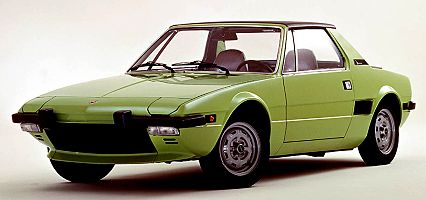 Inside, two individual bucket seats mounted extremely low, a full range of instruments and a four-spoke steering wheel gave a true sports-car feel. Luggage space
was limited inside the cockpit, but the rear boot, with a separate lid behind the engine, was complemented by the front luggage space. The latter was limited if the
removable roof was stored in its position there. Other packaging delights included the almost vertical spare-wheel behind the right-hand seat and the fuel tank
behind the left-hand seat.
Inside, two individual bucket seats mounted extremely low, a full range of instruments and a four-spoke steering wheel gave a true sports-car feel. Luggage space
was limited inside the cockpit, but the rear boot, with a separate lid behind the engine, was complemented by the front luggage space. The latter was limited if the
removable roof was stored in its position there. Other packaging delights included the almost vertical spare-wheel behind the right-hand seat and the fuel tank
behind the left-hand seat.
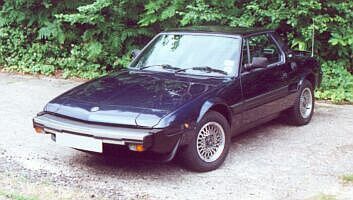 In 1978 the X1/9 was upgraded with the 1498cc engine from the Ritmo and the five speed gearbox from the same source.
In the X1/9 the new engine was rated at 85bhp (67bhp in the US). The front and rear bumpers
were also changed (due to US legislation) - most would agree for the worse,
as was the engine cover (raised to clear the new air cleaner). The dashboard
and interior trim was also updated, with new dials and new seat designs. An injected version was introduced
to the US in 1979, but the power outputs were still severely hampered by emissions legislation.
In 1978 the X1/9 was upgraded with the 1498cc engine from the Ritmo and the five speed gearbox from the same source.
In the X1/9 the new engine was rated at 85bhp (67bhp in the US). The front and rear bumpers
were also changed (due to US legislation) - most would agree for the worse,
as was the engine cover (raised to clear the new air cleaner). The dashboard
and interior trim was also updated, with new dials and new seat designs. An injected version was introduced
to the US in 1979, but the power outputs were still severely hampered by emissions legislation.
Technical Details
| Driveline | transverse engine mid mounted with rear wheel drive |
| Engines | 1290cc (86x55.5mm) sohc four cylinder in-line with 75bhp @ 6,000rpm
1498cc (86.4x63.9mm) sohc four cylinder in-line with 85bhp @ 6,000rpm |
| Fuel Consumption |
1977 X1/9 1500
Simulated urban cycle 26.6mpg / 10.6 l/100km Constant 56mph 47.2mpg / 6.0 l/100km |
| Suspension | front : MacPherson strut with telescopic dampers and coil springs
rear : MacPherson strut with telescopic dampers and coil springs wheelbase : 2202mm front track : 1335mm (1300) or 1355mm (1500) rear track : 1343 (1300) or 1350 (1500) |
| Brakes | front : discs, diameter 227mm
rear : discs, diameter 227mm calliper piston diameters : 48mm (front) & 34mm (rear) handbrake operating on the rear via cable dual hydraulic circuit |
| Gearbox | 4 speed (1300) and 5 speed (1500) manual
Hydraulic clutch disc diameter 181.5mm |
| Steering | Rack and pinion
3 turns lock to lock |
| Kerb weight | 1300 : 880kg
1500 : 920kg |
| Dimensions | click here. |
An exploded drawing of the Weber 32DMTR 34/250 carburettor (as fitted to the 1976 European spec X1/9). (Large file !)
A section through a Fiat X1/9
A plan view of the Fiat X1/9 mechanicals
Performance
| model | max speed | 0-100kph/0-60mph | in gear acceleration | standing ¼ mile | standing km |
| 1300 | 100mph (160kph) | 12 sec | 30-50mph (3rd) : 6.5 | 19.0 sec | 34.7 sec |
| 1500 | 110mph (178kph) | 11 sec | 30-50mph (3rd) : 4.9 | 17.2 sec | 32.3 sec |
Tuning
There are three main areas to concentrate
on, the engine (and transmission), the brakes and the suspension and then
various other details. These three should be done together since they complement
each other, not all of one and none of another !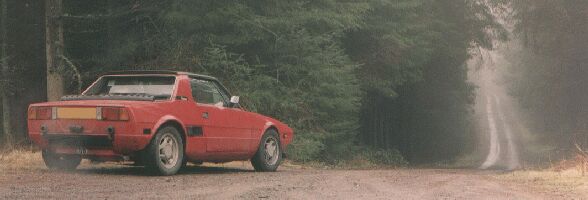 The
X1/9 always had the looks, but it lacked any serious go, and has therefore
been a popular vehicle to modify. The chassis and brakes can handle more
power than was ever fitted as standard, and thus the potential is there.
The
X1/9 always had the looks, but it lacked any serious go, and has therefore
been a popular vehicle to modify. The chassis and brakes can handle more
power than was ever fitted as standard, and thus the potential is there.
1. The engine.
Before modifying the engine it is worthwhile filling it with a good quality synthetic oil and fitting new spark plugs. An engine oil additive may also be used.
The first improvements are relatively simple.
The air filter can be replaced for an aftermarket item which will help
the engine breathe more freely, the type which completely replace the original
airbox are best, and the exhaust can be replaced for one which will restrict
the exit of the gases less.
The main modification (outside of taking
the engine apart) is to fit a better carburettor(s). Twin downdraught 40
DCNFs are popular, sidedraught setups are also possible, but are more difficult
to package. A camshaft will also provide a noticeable gain, especially
if fitted in conjuction with the carburettor.
Further modifications require the machining
of the cylinder headand/or cylinder block (which will not be dealt with
here since it is not normally a DIY job) after which it may be worth fitting
an oil cooler. If overheating is a problem due to the increased power output
then a small hole can also be drilled through the plate in the thermostat.
A more potent solution, and one becoming very popular, is to fit the complete
Uno turbo engine into the X1/9. The engine fits in exactly as the standard
one, the main complications come from the ancilliaries - the intercooler,
oil cooler and exhaust system, but these can be routed in various ways.
This then gives he car the performance to match it's looks.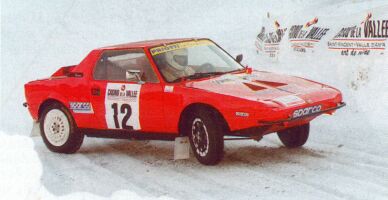 Other things to do should include fitting a cold air intake, a large diameter pipe (minimum 5cm) to provide air from
outside the engine bay (use one of the side ducts) to the air filter. The
exhaust manifold can also be lagged with thermal cloth or tape to keep
the exhaust gases hotter (and thus reduce back pressure) and also to keep
the underbonnet (and hence intake and fuel) temperatures lower. To further
aid this, the vents in the sides should be opened out by removing the fine
plastic grid - the vertical slats can be left to prevent debris entering.
Other things to do should include fitting a cold air intake, a large diameter pipe (minimum 5cm) to provide air from
outside the engine bay (use one of the side ducts) to the air filter. The
exhaust manifold can also be lagged with thermal cloth or tape to keep
the exhaust gases hotter (and thus reduce back pressure) and also to keep
the underbonnet (and hence intake and fuel) temperatures lower. To further
aid this, the vents in the sides should be opened out by removing the fine
plastic grid - the vertical slats can be left to prevent debris entering.
The high tension leads can also be replaced with performance ones.
Another method used by some is to fit the
1600 Fiat twin cam unit. This involves considerably more work and is significantly
heavier than the Uno turbo engine and is not the best solution. The Uno
turbo engine can also be more cheaply modified to produce quite large power outputs.
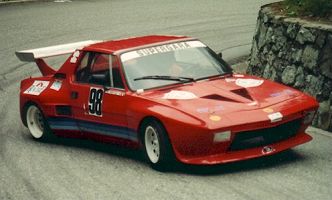 Regarding the transmission, a popular modification for uprated engines is to fit the internals from the Uno turbo gearbox,
the standard X1/9 unit being a bit weak. Whilst doing this it is worthwhile lightening the flywheel.
Regarding the transmission, a popular modification for uprated engines is to fit the internals from the Uno turbo gearbox,
the standard X1/9 unit being a bit weak. Whilst doing this it is worthwhile lightening the flywheel.
2. The brakes.
Initially it is relatively easy to replace
the brake discs with drilled and grooved items, and the pads for a harder
compound. The latter should not be too hard (ie no race pads on the road)
or they will not function effectively at the normal 'road' operating temperatures.
Stainless steel braided flexible hoses will improve the pedal feel and
reduce the chance of damage whilst DoT5 fluid (not silicon) will increase
the temperature at which it can operate effectively. If the brakes are
getting too hot the dustguards can be removed and/or ducts fitted, taking
air from behind the front bumper.
A small improvement can be obtained by
fitting FIAT 132 rear callipers. These have a larger piston diameter (38mm
compared to 34mm) than the standard X1/9 units and thus improve the bias
towards the rear of the car. If required the brakes from the Uno turbo
(larger, ventilated discs) can be fitted. If more serious braking is required
the next modification would be to increase the disc size. It is possible
to use larger discs with a bracket allowing use of the production callipers,
or alloy four pot callipers can be fitted.
In order to improve the balance of the
car under braking it is desireable to be able to adjust the balance of
braking from front to rear (and vice versa). This can be accomplished by
fitting a bias valve in the line to the rear brakes, usually in a position
so that it can be reached from the drivers seat.
3. The suspension.
The easiest improvement,and the one which
will probably bring the single most noticeable change, is to replace the
dampers and springs. Fitting lowered springs will improve the cornering,
but must be fitted together with shortened throw dampers, or else the springs
may unseat ! Top adjustable dampers are compromised, but are good for road
and track day cars since it allows the There are then two other main suspension
aims; to reduce the flexiblity in the suspension and to increase the stiffness
of the car, both of which aim at more accurate control of the wheel movement.
To reduce the flexibility it is possible to fit nylon bushes instead of
the normal production rubber items, or if perfection is desired the suspension
can be fitted with metallic bearings (rose joints / rod ends). Spherical
bearing top mounts can also be used. To stiffen the car it is most popular
to fit a strut brace at the front. For more extreme cases a rollcage can be fitted.....
Into this category also fall the choice
of wheels and tyres. With an increase in power it can be necessary to fit
larger tyres (thus requiring larger wheels) but the temptation to fit the
biggest possible should be resisted. Consideration should be given to fitting
a wider tyre on the rear (since they provide traction) but keeping the
standard, or a wider but not as wide as the rear, tyre at the front. This
will improve the balance of the car and not make the steering too heavy.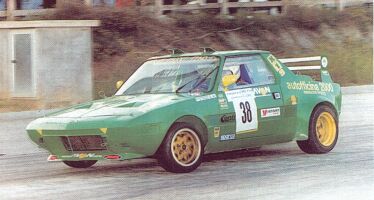 suspension
to be adjusted between these two, rather different, requirements. Coil
over units add more adjustability and can be purchased outright, or can
be made from standard dampers by welding a threaded sleeve to the standardtube.
suspension
to be adjusted between these two, rather different, requirements. Coil
over units add more adjustability and can be purchased outright, or can
be made from standard dampers by welding a threaded sleeve to the standardtube.
4. other things.
Other modifications worth considering include fitment of a shift light (and rev limiter if there is not one as standard), higher power bulbs in the headlights (if you are going to go faster you need to see further) and installation of a quicker steering rack.
Maintenance
The X1/9 was never very complicated, being
one of the last non-electronic cars. Service is quite easy with no major
accessibility problems despite the compact layout.
If you have just purchased a second hand
car there are several components which are worthwhile changing.
As with any older second hand car the following
should be changed for increased reliability, safety and general health :
It is worth taking a bit of time after
purchase to check the car well - it may save much annoyance later !
It is recommended to jack up each corner
of the car in turn and check the wheel bearings, brake discs, brake pads,
flexible brake hoses, rubber suspension bushes and driveshaft CV joint gaiters.
Under the engine cover check the HT leads,
distributor cap and rotor arm, engine earth lead and the condition of the
fuel hoses. With older cars it is always worthwhile buying a can of fuel
system cleaner and pouring it into the tank (or spraying it into the carburettor)
- the internals of engines can easily clog up depending on prior useage.
Slick 50 or a similar substance is also recommended for both increasing
the (remaining) engine life and also reducing the noise, especially at
tickover. Whilst there, the cooling system should be drained, generously
flushed (chemicals can be purchased to assist this) and refilled with the
required anti-freeze added. Also check the battery terminals/leads under the bonnet.
Other things to check (to prevent any unpleasant surprises when going somewhere)
are the operation of all lights (don't forget to try the indicators with
the sidelights on - they sometimes all blink together!) and the correct
operation of the radiator cooling fan.
Problems can be encountered with the carburettor,
but these are usually resolved by dismantling and cleaning it. The brake callipers also have a tendency to
seize due to corrosion between the fixed bracket, the metal wedge and the sliding portion. It is a wise precaution to
dismantle, clean and regrease these every few months (especially after the winter of infrequent use).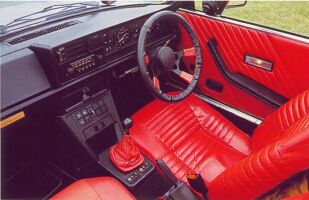 Engine oil and filter were sheduled for changing at 6000 miles, spark plugs and
air filter at 12000.
Engine oil and filter were sheduled for changing at 6000 miles, spark plugs and
air filter at 12000.
Spark Plugs, oil, oil filter, air filter,
brake fluid, windscreen wiper blade(s).
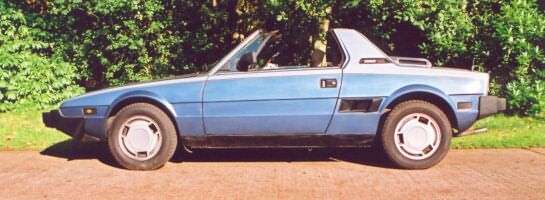 Unless a history is provided, it is recommended to replace the timing belt and alternator/water pump belt since these items
can fail and if they do the car will go nowhere ! Always use manufacturers
belts, NOT aftermarket ones !
Unless a history is provided, it is recommended to replace the timing belt and alternator/water pump belt since these items
can fail and if they do the car will go nowhere ! Always use manufacturers
belts, NOT aftermarket ones !
Buying / Selling
Some tips to do before selling :
(they may seem obvious, but most people don't do them and thus are in a
weaker bargaining position).
Tidy inside the car thoroughly : hoover
the floor, empty all pockets, ashtrays (wash), glove compartment etc...,
wipe the trim with a damp cloth, give the cockpit a good airing to get
rid of any odours ! Reset the trip meter to 00000 - it is a pleasant (subconcious) surprise.
'Back to black' products are very effective
at temporarily restoring bumpers and trim. This makes a big difference
to any car. Do it a week before you expect people to view the car, otherwise
it may be a bit too obvious !
Jetwash under the car, especially under
the engine and in the wheelarches. The prospective buyer may be an enthusiast,
and this makes it easier for them to see what they want to check.
Obviously wash the car and clean the windows !
If you are going to buy a car always check the following :
Firstly check the bodywork. Pay special
attention to the wheelarches (inside if there is no plastic splash guard),
suspension and engine mounts, sill, door pillars (check for sagging doors),
scuttle panel and the floor (doors, bonnet and boot/hatch are also susceptible, but are more easily replaced).
Check that there are no mismatching panels,
large areas of discolouration or signs of fresh paint (compare inside the
engine bay with the external body colour), all of which probably indicate accident damage.
Check the brake pedal does not go to the
floor if pressed hard for a long time and check the gearchange for clean engagement.
The engine should be run up to temperature,
check the exhaust for smoke, the condition of the breather (look for mayonaise),
the condition of the oil filler cap (again white deposits can indicate head
gasket or other serious problems or the use of the car only on short journeys,
another bad state of affairs) and the colour of the coolant (preferably
not thick or dark brown!). Listen to the noise of the engine, then depress
the clutch and engage first gear. Whatever noise has disappeared was coming
form the gearbox, what remains is from the engine. Also check the condition
of the engine oil on the dipstick.The lighter brown the better, if it is thick black then leave quickly.
Check tyre wear, uneven patterns could imply a bent chassis.
Always take it for a test drive. Check
that the car tracks in a straight line with no steering input and also
remains straight under braking. Find a large open area and complete several
lock to lock turns (also in reverse), listening for any noises. Try the
handbrake when moving - seized rear callipers (common on the X1/9) will
mean uneven braking or no braking.
Gearbox's are a weak point, check it doesn't
jump out of reverse, and check the synchro between second and third gears.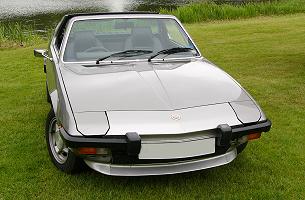 If the car has been standing give it a
good run - this will clear out the engine (reduce exhaust smoke), put a
shine on the brake discs and loosen up any joints that may otherwise make some noises.
If the car has been standing give it a
good run - this will clear out the engine (reduce exhaust smoke), put a
shine on the brake discs and loosen up any joints that may otherwise make some noises.
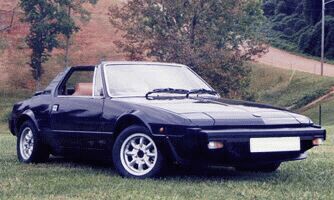 Check for a damp carpet or the presence of mould - if the carpet is damp then
the floor is almost certainly corroded.
Check for a damp carpet or the presence of mould - if the carpet is damp then
the floor is almost certainly corroded.
Dampers should be checked (bounce the
corner up and down) as should the steering rack for excessive play.
Check the main electrical functions -
wipers, lights, etc... try putting the main beam and wipers on at the same
time. Check the headlight reflectors for rust. Try the electric windows
(if fitted), these are often getting rather weak.
Links
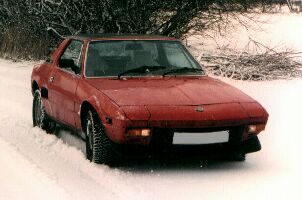 The
UK X1/9 owners club website
The
UK X1/9 owners club website
Another X1/9 Website with some interesting cars
Another personal X1/9 website
The Denmark X1/9 owners club website
The Denmark X1/9 owners club website
The German X1/9 Owners Club website
The Italian X1/9 Owners Club website
The American X1/9 Owners Club website
Fiat X1/9 Books : buy them online here
(in association with Amazon)
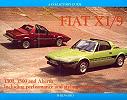 Fiat X1/9 : A collectors guide : 1300, 1500 &
Abarth including performance and styling conversions
Fiat X1/9 : A collectors guide : 1300, 1500 &
Abarth including performance and styling conversions
| Phil Ward |
 Fiat
Road Test Book : Fiat X1/9 Gold Portfolio 1973-1989 Fiat
Road Test Book : Fiat X1/9 Gold Portfolio 1973-1989
48 articles and over 300 illustrations. |
edited by R.M.Clarke, 1996 |
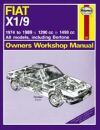 Fiat
X1/9 ('74 to '89) Workshop Manual Fiat
X1/9 ('74 to '89) Workshop Manual |
Haynes, 1989 |
For more books on Fiats, see our Online Bookstore
Fiat X1/9 comment form
Your Comments
I've had an 89 registered
Bertone X1-9 since 1992. It's been reliable and a great deal of fun
to drive - in the dry, it's hard to break loose on any corner. Not
a lot of power, and the feel of the brakes is a little soft: otherwise,
a marvellous little car. (David P, New Zealand)
Bought a 1976 X1/9. It is in complete original condition and a pleasure to drive. Looking at buying
another one to do some engine mods and play around with. I have become
a X1/9 fan overnight, can't wait to get home and take her for a spin round the block. (Pierre, South Africa)
I've wanted an X1/9 since I was a kid. I recently I aquired a silver 1500, and absolutely love it. the steering is razor-blade sharp and it flies along at
deceptive speed. not the most reliable car I've owned (that prize goes to Fiat Tipo)- but certainly the most fun.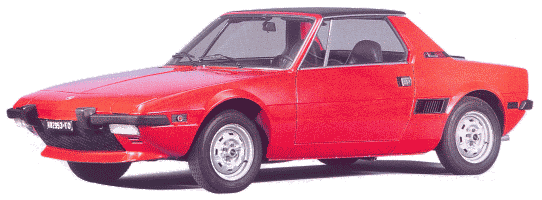 Bonjour,
je viens de faire l'achat d'une x 1/9 bertone 1986. c'est la premiere fois
que je décide a me faire plaisir. j'aimerais beaucoup entendre ou
lire sur des adeptes de fiat x 1/9 au québec ou ailleur. (François-x)
Bonjour,
je viens de faire l'achat d'une x 1/9 bertone 1986. c'est la premiere fois
que je décide a me faire plaisir. j'aimerais beaucoup entendre ou
lire sur des adeptes de fiat x 1/9 au québec ou ailleur. (François-x)
There is also a list of all our picture galleries (including museums, motorshows and various events).
Wallpapers/Desktop Backgrounds of numerous Fiats also available to download.
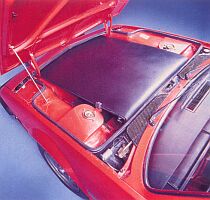
Use the buttons at the top to navigate further, or
Copyright © 2000 to 2008 CarsfromItaly